Biology
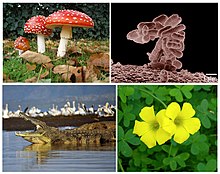
| Part of a series on |
| Biology |
|---|
Biology is the
Biologists are able to study life at multiple levels of organization,[1] from the molecular biology of a cell to the anatomy and physiology of plants and animals, and evolution of populations.[1][6] Hence, there are multiple subdisciplines within biology, each defined by the nature of their research questions and the tools that they use.[7][8][9] Like other scientists, biologists use the scientific method to make observations, pose questions, generate hypotheses, perform experiments, and form conclusions about the world around them.[1]
Life on Earth, which emerged more than 3.7 billion years ago,
History
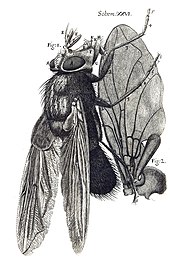
The earliest of roots of science, which included medicine, can be traced to
Biology began to quickly develop with
Meanwhile, taxonomy and classification became the focus of natural historians. Carl Linnaeus published a basic taxonomy for the natural world in 1735, and in the 1750s introduced scientific names for all his species.[20] Georges-Louis Leclerc, Comte de Buffon, treated species as artificial categories and living forms as malleable—even suggesting the possibility of common descent.[21]

Serious evolutionary thinking originated with the works of
The basis for modern genetics began with the work of
Chemical basis
Atoms and molecules
All organisms are made up of chemical elements;[30] oxygen, carbon, hydrogen, and nitrogen account for most (96%) of the mass of all organisms, with calcium, phosphorus, sulfur, sodium, chlorine, and magnesium constituting essentially all the remainder. Different elements can combine to form compounds such as water, which is fundamental to life.[30] Biochemistry is the study of chemical processes within and relating to living organisms. Molecular biology is the branch of biology that seeks to understand the molecular basis of biological activity in and between cells, including molecular synthesis, modification, mechanisms, and interactions.
Water
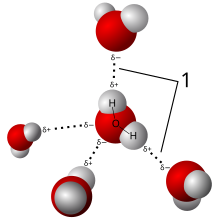
Life arose from the Earth's first ocean, which formed some 3.8 billion years ago.
Organic compounds

Organic compounds are molecules that contain carbon bonded to another element such as hydrogen.[31] With the exception of water, nearly all the molecules that make up each organism contain carbon.[31][32] Carbon can form covalent bonds with up to four other atoms, enabling it to form diverse, large, and complex molecules.[31][32] For example, a single carbon atom can form four single covalent bonds such as in methane, two double covalent bonds such as in carbon dioxide (CO2), or a triple covalent bond such as in carbon monoxide (CO). Moreover, carbon can form very long chains of interconnecting carbon–carbon bonds such as octane or ring-like structures such as glucose.
The simplest form of an organic molecule is the hydrocarbon, which is a large family of organic compounds that are composed of hydrogen atoms bonded to a chain of carbon atoms. A hydrocarbon backbone can be substituted by other elements such as oxygen (O), hydrogen (H), phosphorus (P), and sulfur (S), which can change the chemical behavior of that compound.[31] Groups of atoms that contain these elements (O-, H-, P-, and S-) and are bonded to a central carbon atom or skeleton are called functional groups.[31] There are six prominent functional groups that can be found in organisms: amino group, carboxyl group, carbonyl group, hydroxyl group, phosphate group, and sulfhydryl group.[31]
In 1953, the Miller–Urey experiment showed that organic compounds could be synthesized abiotically within a closed system mimicking the conditions of early Earth, thus suggesting that complex organic molecules could have arisen spontaneously in early Earth (see abiogenesis).[33][31]
Macromolecules
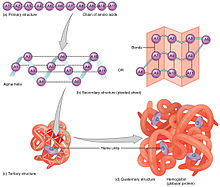
Macromolecules are large molecules made up of smaller subunits or monomers.[34] Monomers include sugars, amino acids, and nucleotides.[35] Carbohydrates include monomers and polymers of sugars.[36] Lipids are the only class of macromolecules that are not made up of polymers. They include steroids, phospholipids, and fats,[35] largely nonpolar and hydrophobic (water-repelling) substances.[37] Proteins are the most diverse of the macromolecules. They include
Cells
Cell structure

Every cell is enclosed within a
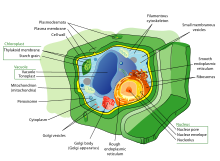
Within the cytoplasm of a cell, there are many biomolecules such as
Metabolism
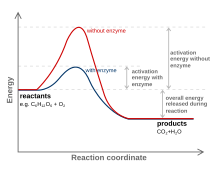
All cells require energy to sustain cellular processes.
Cellular respiration

Cellular respiration is a set of metabolic reactions and processes that take place in cells to convert
Sugar in the form of glucose is the main nutrient used by animal and plant cells in respiration. Cellular respiration involving oxygen is called aerobic respiration, which has four stages: glycolysis, citric acid cycle (or Krebs cycle), electron transport chain, and oxidative phosphorylation.[48] Glycolysis is a metabolic process that occurs in the cytoplasm whereby glucose is converted into two pyruvates, with two net molecules of ATP being produced at the same time.[48] Each pyruvate is then oxidized into acetyl-CoA by the pyruvate dehydrogenase complex, which also generates NADH and carbon dioxide. Acetyl-Coa enters the citric acid cycle, which takes places inside the mitochondrial matrix. At the end of the cycle, the total yield from 1 glucose (or 2 pyruvates) is 6 NADH, 2 FADH2, and 2 ATP molecules. Finally, the next stage is oxidative phosphorylation, which in eukaryotes, occurs in the mitochondrial cristae. Oxidative phosphorylation comprises the electron transport chain, which is a series of four protein complexes that transfer electrons from one complex to another, thereby releasing energy from NADH and FADH2 that is coupled to the pumping of protons (hydrogen ions) across the inner mitochondrial membrane (chemiosmosis), which generates a proton motive force.[48] Energy from the proton motive force drives the enzyme ATP synthase to synthesize more ATPs by phosphorylating ADPs. The transfer of electrons terminates with molecular oxygen being the final electron acceptor.
If oxygen were not present, pyruvate would not be metabolized by cellular respiration but undergoes a process of fermentation. The pyruvate is not transported into the mitochondrion but remains in the cytoplasm, where it is converted to waste products that may be removed from the cell. This serves the purpose of oxidizing the electron carriers so that they can perform glycolysis again and removing the excess pyruvate. Fermentation oxidizes NADH to NAD+ so it can be re-used in glycolysis. In the absence of oxygen, fermentation prevents the buildup of NADH in the cytoplasm and provides NAD+ for glycolysis. This waste product varies depending on the organism. In skeletal muscles, the waste product is lactic acid. This type of fermentation is called lactic acid fermentation. In strenuous exercise, when energy demands exceed energy supply, the respiratory chain cannot process all of the hydrogen atoms joined by NADH. During anaerobic glycolysis, NAD+ regenerates when pairs of hydrogen combine with pyruvate to form lactate. Lactate formation is catalyzed by lactate dehydrogenase in a reversible reaction. Lactate can also be used as an indirect precursor for liver glycogen. During recovery, when oxygen becomes available, NAD+ attaches to hydrogen from lactate to form ATP. In yeast, the waste products are ethanol and carbon dioxide. This type of fermentation is known as alcoholic or ethanol fermentation. The ATP generated in this process is made by substrate-level phosphorylation, which does not require oxygen.
Photosynthesis

Photosynthesis is a process used by plants and other organisms to
Photosynthesis has four stages:
During the third stage of photosynthesis, the movement of protons down their
Cell signaling
Cell signaling (or communication) is the ability of
Cell cycle

The cell cycle is a series of events that take place in a
Sexual reproduction and meiosis
Meiosis is a central feature of sexual reproduction in eukaryotes, and the most fundamental function of meiosis appears to be conservation of the integrity of the genome that is passed on to progeny by parents.[62][63] Two aspects of sexual reproduction, meiotic recombination and outcrossing, are likely maintained respectively by the adaptive advantages of recombinational repair of genomic DNA damage and genetic complementation which masks the expression of deleterious recessive mutations.[64]
The beneficial effect of genetic complementation, derived from outcrossing (cross-fertilization) is also referred to as hybrid vigor or heterosis. Charles Darwin in his 1878 book The Effects of Cross and Self-Fertilization in the Vegetable Kingdom[65] at the start of chapter XII noted “The first and most important of the conclusions which may be drawn from the observations given in this volume, is that generally cross-fertilisation is beneficial and self-fertilisation often injurious, at least with the plants on which I experimented.” Genetic variation, often produced as a byproduct of sexual reproduction, may provide long-term advantages to those sexual lineages that engage in outcrossing.[64]
Genetics
Inheritance
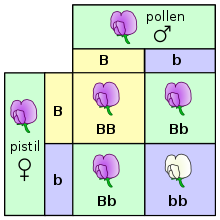
Genes and DNA
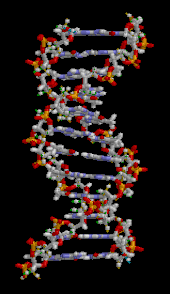
A gene is a unit of heredity that corresponds to a region of deoxyribonucleic acid (DNA) that carries genetic information that controls form or function of an organism. DNA is composed of two polynucleotide chains that coil around each other to form a double helix.[71] It is found as linear chromosomes in eukaryotes, and circular chromosomes in prokaryotes. The set of chromosomes in a cell is collectively known as its genome. In eukaryotes, DNA is mainly in the cell nucleus.[72] In prokaryotes, the DNA is held within the nucleoid.[73] The genetic information is held within genes, and the complete assemblage in an organism is called its genotype.[74] DNA replication is a semiconservative process whereby each strand serves as a template for a new strand of DNA.[71] Mutations are heritable changes in DNA.[71] They can arise spontaneously as a result of replication errors that were not corrected by proofreading or can be induced by an environmental mutagen such as a chemical (e.g., nitrous acid, benzopyrene) or radiation (e.g., x-ray, gamma ray, ultraviolet radiation, particles emitted by unstable isotopes).[71] Mutations can lead to phenotypic effects such as loss-of-function, gain-of-function, and conditional mutations.[71] Some mutations are beneficial, as they are a source of genetic variation for evolution.[71] Others are harmful if they were to result in a loss of function of genes needed for survival.[71]
Gene expression
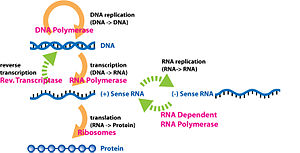
Gene expression is the molecular process by which a
Gene regulation
The regulation of gene expression by environmental factors and during different stages of development can occur at each step of the process such as transcription, RNA splicing, translation, and post-translational modification of a protein.[79] Gene expression can be influenced by positive or negative regulation, depending on which of the two types of regulatory proteins called transcription factors bind to the DNA sequence close to or at a promoter.[79] A cluster of genes that share the same promoter is called an operon, found mainly in prokaryotes and some lower eukaryotes (e.g., Caenorhabditis elegans).[79][80] In positive regulation of gene expression, the activator is the transcription factor that stimulates transcription when it binds to the sequence near or at the promoter. Negative regulation occurs when another transcription factor called a repressor binds to a DNA sequence called an operator, which is part of an operon, to prevent transcription. Repressors can be inhibited by compounds called inducers (e.g., allolactose), thereby allowing transcription to occur.[79] Specific genes that can be activated by inducers are called inducible genes, in contrast to constitutive genes that are almost constantly active.[79] In contrast to both, structural genes encode proteins that are not involved in gene regulation.[79] In addition to regulatory events involving the promoter, gene expression can also be regulated by epigenetic changes to chromatin, which is a complex of DNA and protein found in eukaryotic cells.[79]
Genes, development, and evolution
Evolution
Evolutionary processes

Speciation
A species is a group of organisms that mate with one another and speciation is the process by which one lineage splits into two lineages as a result of having evolved independently from each other.[94] For speciation to occur, there has to be reproductive isolation.[94] Reproductive isolation can result from incompatibilities between genes as described by Bateson–Dobzhansky–Muller model. Reproductive isolation also tends to increase with genetic divergence. Speciation can occur when there are physical barriers that divide an ancestral species, a process known as allopatric speciation.[94]
Phylogeny

A phylogeny is an evolutionary history of a specific group of organisms or their genes.[95] It can be represented using a phylogenetic tree, a diagram showing lines of descent among organisms or their genes. Each line drawn on the time axis of a tree represents a lineage of descendants of a particular species or population. When a lineage divides into two, it is represented as a fork or split on the phylogenetic tree.[95] Phylogenetic trees are the basis for comparing and grouping different species.[95] Different species that share a feature inherited from a common ancestor are described as having homologous features (or synapomorphy).[96][97][95] Phylogeny provides the basis of biological classification.[95] This classification system is rank-based, with the highest rank being the domain followed by kingdom, phylum, class, order, family, genus, and species.[95] All organisms can be classified as belonging to one of three domains: Archaea (originally Archaebacteria); bacteria (originally eubacteria), or eukarya (includes the protist, fungi, plant, and animal kingdoms).[98]
History of life
The history of life on Earth traces how organisms have evolved from the earliest emergence of life to present day. Earth formed about 4.5 billion years ago and all life on Earth, both living and extinct, descended from a
The similarities among all known present-day
Algae-like multicellular land plants are dated back even to about 1 billion years ago,[111] although evidence suggests that microorganisms formed the earliest terrestrial ecosystems, at least 2.7 billion years ago.[112] Microorganisms are thought to have paved the way for the inception of land plants in the Ordovician period. Land plants were so successful that they are thought to have contributed to the Late Devonian extinction event.[113]
Diversity
Bacteria and Archaea

Bacteria are a type of
The first observed archaea were
Archaea are a major part of
Eukaryotes

Eukaryotes are hypothesized to have split from archaea, which was followed by their
Plants are mainly multicellular
Animals are multicellular eukaryotes. With few exceptions, animals
Viruses
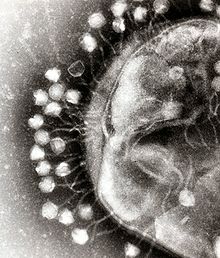
Viruses are
The origins of viruses in the
Ecology
Ecology is the study of the distribution and abundance of life, the interaction between organisms and their environment.[145]
Ecosystems
The
Populations
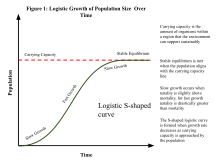
A population is the group of
Communities
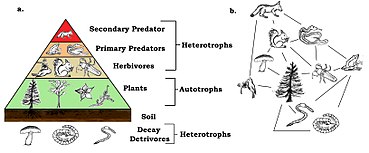
A community is a group of populations of species occupying the same geographical area at the same time. A biological interaction is the effect that a pair of organisms living together in a community have on each other. They can be either of the same species (intraspecific interactions), or of different species (interspecific interactions). These effects may be short-term, like pollination and predation, or long-term; both often strongly influence the evolution of the species involved. A long-term interaction is called a symbiosis. Symbioses range from mutualism, beneficial to both partners, to competition, harmful to both partners.[158] Every species participates as a consumer, resource, or both in consumer–resource interactions, which form the core of food chains or food webs.[159] There are different trophic levels within any food web, with the lowest level being the primary producers (or autotrophs) such as plants and algae that convert energy and inorganic material into organic compounds, which can then be used by the rest of the community.[52][160][161] At the next level are the heterotrophs, which are the species that obtain energy by breaking apart organic compounds from other organisms.[159] Heterotrophs that consume plants are primary consumers (or herbivores) whereas heterotrophs that consume herbivores are secondary consumers (or carnivores). And those that eat secondary consumers are tertiary consumers and so on. Omnivorous heterotrophs are able to consume at multiple levels. Finally, there are decomposers that feed on the waste products or dead bodies of organisms.[159] On average, the total amount of energy incorporated into the biomass of a trophic level per unit of time is about one-tenth of the energy of the trophic level that it consumes. Waste and dead material used by decomposers as well as heat lost from metabolism make up the other ninety percent of energy that is not consumed by the next trophic level.[162]
Biosphere
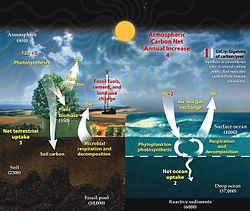
In the global ecosystem or biosphere, matter exists as different interacting compartments, which can be biotic or abiotic as well as accessible or inaccessible, depending on their forms and locations.[164] For example, matter from terrestrial autotrophs are both biotic and accessible to other organisms whereas the matter in rocks and minerals are abiotic and inaccessible. A biogeochemical cycle is a pathway by which specific elements of matter are turned over or moved through the biotic (biosphere) and the abiotic (lithosphere, atmosphere, and hydrosphere) compartments of Earth. There are biogeochemical cycles for nitrogen, carbon, and water.
Conservation
Conservation biology is the study of the conservation of Earth's
See also
- Biology in fiction
- Glossary of biology
- List of biological websites
- List of biologists
- List of biology journals
- List of biology topics
- List of life sciences
- List of omics topics in biology
- National Association of Biology Teachers
- Outline of biology
- Periodic table of life sciences in Tinbergen's four questions
- Science tourism
- Terminology of biology
References
- ^ ISBN 978-0134093413.
- ^ ISBN 978-1319017644.
- ^ ISBN 978-0321976499.
- PMID 26628646.
- PMID 23159919.
- ^ Based on definition from: "Aquarena Wetlands Project glossary of terms". Texas State University at San Marcos. Archived from the original on 2004-06-08.
- ISBN 978-0-19-965857-2.
- S2CID 119808230.
- ^ Howell, Elizabeth (8 December 2014). "How Did Life Become Complex, And Could It Happen Beyond Earth?". Astrobiology Magazine. Archived from the original on 17 August 2018. Retrieved 14 February 2018.
{{cite web}}: CS1 maint: unfit URL (link) - ^ S2CID 4419671.
- ^ ISBN 978-0-226-48205-7.
- ^ ISBN 978-052-1-68957-1.
- ISBN 978-0-203-91100-6. Archivedfrom the original on 2015-03-24.
- ISBN 978-1-4899-6327-7. Archivedfrom the original on 15 April 2021. Retrieved 14 July 2015.
- ^ One or more of the preceding sentences incorporates text from a publication now in the public domain: Chisholm, Hugh, ed. (1911). "Theophrastus". Encyclopædia Britannica (11th ed.). Cambridge University Press.
- ISBN 978-0-415-12410-2.
- ISBN 978-0-203-91100-6. Archivedfrom the original on 2015-03-24.
- ISBN 978-0-19-515618-8.
- ISBN 978-0-521-29293-1.
- ^ Mayr, Ernst. The Growth of Biological Thought, chapter 4
- ^ Mayr, Ernst. The Growth of Biological Thought, chapter 7
- (PDF) from the original on 4 March 2016. Retrieved 27 November 2014.
- ISBN 0-674-00613-5. p. 187.
- ^ Mayr, Ernst. The Growth of Biological Thought, chapter 10: "Darwin's evidence for evolution and common descent"; and chapter 11: "The causation of evolution: natural selection"
- ISBN 978-1-58836-538-5. Archivedfrom the original on 2015-03-24.
- ^ Henig (2000). Op. cit. pp. 134–138.
- ^ a b Miko, Ilona (2008). "Gregor Mendel's principles of inheritance form the cornerstone of modern genetics. So just what are they?". Nature Education. 1 (1): 134. Archived from the original on 2019-07-19. Retrieved 2021-05-13.
- ^ Futuyma, Douglas J.; Kirkpatrick, Mark (2017). "Evolutionary Biology". Evolution (4th ed.). Sunderland, Mass.: Sinauer Associates. pp. 3–26.
- ^ Noble, Ivan (2003-04-14). "Human genome finally complete". BBC News. Archived from the original on 2006-06-14. Retrieved 2006-07-22.
- ^ ISBN 978-0134093413.
- ^ ISBN 978-0321976499.
- ^ ISBN 978-0134093413.
- ISBN 978-1464175121.
- ^ ISBN 978-0321976499.
- ^ ISBN 978-0134093413.
- ISBN 978-0321976499.
- ISBN 978-0321976499.
- ISBN 978-0321976499.
- ISBN 0-333-49756-2.
- S2CID 7338204.
- ISBN 978-0132508827. Archivedfrom the original on 2014-11-02. Retrieved 2021-05-13.
- ISBN 978-0134093413.
- ISBN 978-0-8153-3218-3. Archivedfrom the original on 2017-12-20.
- from the original on February 17, 2022. Retrieved May 14, 2021.
- ^ Alberts, Bruce; Johnson, Alexander; Lewis, Julian; Raff, Martin; Roberts, Keith; Walter, Peter (2002). "Cell Movements and the Shaping of the Vertebrate Body". Molecular Biology of the Cell (4th ed.). Archived from the original on 2020-01-22. Retrieved 2021-05-13. The Alberts text discusses how the "cellular building blocks" move to shape developing embryos. It is also common to describe small molecules such as amino acids as "molecular building blocks Archived 2020-01-22 at the Wayback Machine".
- ^ ISBN 978-1464175121.
- ^ Bailey, Regina. "Cellular Respiration". Archived from the original on 2012-05-05.
- ^ ISBN 978-0716776017.
- ^ "photosynthesis". Online Etymology Dictionary. Archived from the original on 2013-03-07. Retrieved 2013-05-23.
- Perseus Project
- Perseus Project
- ^ PMID 16997562.
- ISBN 978-0-321-73975-9.
This initial incorporation of carbon into organic compounds is known as carbon fixation.
- ^ Neitzel, James; Rasband, Matthew. "Cell communication". Nature Education. Archived from the original on 29 September 2010. Retrieved 29 May 2021.
- ^ a b "Cell signaling". Nature Education. Archived from the original on 31 October 2010. Retrieved 29 May 2021.
- ^ ISBN 978-1464175121.
- OCLC 176818780.
- OCLC 698085201.
- ^ "10.2 The Cell Cycle – Biology 2e | OpenStax". openstax.org. 28 March 2018. Archived from the original on 2020-11-29. Retrieved 2020-11-24.
- ISBN 978-0321976499.
- PMID 32046082.
- ^ Brandeis M. New-age ideas about age-old sex: separating meiosis from mating could solve a century-old conundrum. Biol Rev Camb Philos Soc. 2018 May;93(2):801-810. doi: 10.1111/brv.12367. Epub 2017 Sep 14. PMID: 28913952
- ^ Hörandl E. Apomixis and the paradox of sex in plants. Ann Bot. 2024 Mar 18:mcae044. doi: 10.1093/aob/mcae044. Epub ahead of print. PMID: 38497809
- ^ a b Bernstein H, Byerly HC, Hopf FA, Michod RE. Genetic damage, mutation, and the evolution of sex. Science. 1985 Sep 20;229(4719):1277-81. doi: 10.1126/science.3898363. PMID: 3898363
- ^ Darwin, C. R. 1878. The effects of cross and self fertilisation in the vegetable kingdom. London: John Murray". darwin-online.org.uk
- ISBN 978-1464109485.
- ISBN 978-0-7167-3520-5.
- ISBN 978-0-7637-1511-3.
- ^ Miko, Ilona (2008). "Test crosses". Nature Education. 1 (1): 136. Archived from the original on 2021-05-21. Retrieved 2021-05-28.
- ^ Miko, Ilona (2008). "Thomas Hunt Morgan and sex linkage". Nature Education. 1 (1): 143. Archived from the original on 2021-05-20. Retrieved 2021-05-28.
- ^ ISBN 978-1464175121.
- ISBN 0-8053-4553-1.
- S2CID 25355087.
- ^ "Genotype definition – Medical Dictionary definitions". Medterms.com. 2012-03-19. Archived from the original on 2013-09-21. Retrieved 2013-10-02.
- PMID 13580867.
- S2CID 4164029.
- S2CID 4184060.
- PMID 26990983.
- ^ ISBN 978-1464175121.
- PMID 12086614.
- ^ ISBN 978-1464175121.
- ^ Slack, J.M.W. (2013) Essential Developmental Biology. Wiley-Blackwell, Oxford.
- S2CID 3353748.
- ISBN 978-0-12-385943-3. Archivedfrom the original on 2021-04-12. Retrieved 2021-05-28.
- PMID 20436487.
- ^ Carroll, Sean B. "The Origins of Form". Natural History. Archived from the original on 9 October 2018. Retrieved 9 October 2016.
Biologists could say, with confidence, that forms change, and that natural selection is an important force for change. Yet they could say nothing about how that change is accomplished. How bodies or body parts change, or how new structures arise, remained complete mysteries.
- ISBN 978-1-4496-4722-3. Archivedfrom the original on 2023-03-26. Retrieved 2021-05-27.
- ^ "Evolution Resources". Washington, D.C.: National Academies of Sciences, Engineering, and Medicine. 2016. Archived from the original on 2016-06-03.
- ^ ISBN 978-0134093413.
- (PDF) from the original on 2015-02-06.
- ^ Darwin, Charles (1859). On the Origin of Species, John Murray.
- ^ Futuyma, Douglas J.; Kirkpatrick, Mark (2017). "Evolutionary biology". Evolution (4th ed.). Sunderland, Mass.: Sinauer Associates. pp. 3–26.
- ISBN 978-1464175121.
- ^ ISBN 978-1464175121.
- ^ ISBN 978-1464175121.
- ISBN 9780123847201. Archivedfrom the original on 29 August 2021. Retrieved 29 August 2021.)
- ^ Futuyma, Douglas J.; Kirkpatrick, Mark (2017). "Phylogeny: The unity and diversity of life". Evolution (4th ed.). Sunderland, Mass.: Sinauer Associates. pp. 401–429.
- PMID 2112744.
- from the original on 2018-03-20.
- ISBN 978-0-19-515605-8.
- ^ ISBN 978-1464175121.
- ^ "Stratigraphic Chart 2022" (PDF). International Stratigraphic Commission. February 2022. Archived (PDF) from the original on 2 April 2022. Retrieved 25 April 2022.
- ^ Futuyma 2005
- OCLC 57311264.
- PMID 9924024.
- doi:10.1038/ngeo2025.
- PMC 1690475.
- PMID 16754612.
- S2CID 55178329. Archived from the original(PDF) on 2009-02-26. Retrieved 2008-09-02.
- .
- S2CID 4418860.
- .
- PMC 1692181.
- PMID 10781044.
- S2CID 4402854. Archived from the original(PDF) on 2009-02-26. Retrieved 2015-01-22.
- ^ Hoyt, Donald F. (February 17, 1997). "Synapsid Reptiles". ZOO 138 Vertebrate Zoology (Lecture). Pomona, Calif.: California State Polytechnic University, Pomona. Archived from the original on 2009-05-20. Retrieved 2015-01-22.
- ^ Barry, Patrick L. (January 28, 2002). Phillips, Tony (ed.). "The Great Dying". Science@NASA. Marshall Space Flight Center. Archived from the original on 2010-04-10. Retrieved 2015-01-22.
- doi:10.1016/S0012-8252(03)00082-5. Archived from the original(PDF) on 2007-10-25. Retrieved 2007-10-22.
- OCLC 37378512.
- (PDF) from the original on 2019-03-22. Retrieved 2015-01-23.
- ^ Roach, John (June 20, 2007). "Dinosaur Extinction Spurred Rise of Modern Mammals". National Geographic News. Washington, D.C.: National Geographic Society. Archived from the original on 2008-05-11. Retrieved 2020-02-21.
- Wible, John R.; Rougier, Guillermo W.; Novacek, Michael J.; et al. (June 21, 2007). "Cretaceous eutherians and Laurasian origin for placental mammals near the K/T boundary". S2CID 4334424.
- Wible, John R.; Rougier, Guillermo W.; Novacek, Michael J.; et al. (June 21, 2007). "Cretaceous eutherians and Laurasian origin for placental mammals near the K/T boundary".
- from the original on February 29, 2020. Retrieved May 15, 2021.
- PMID 15240306.
- (PDF) from the original on 2021-03-08. Retrieved 2021-05-14.
- S2CID 4431143.
- PMID 7287626.
- ^ "Archaea Basic Biology". March 2018. Archived from the original on 2021-04-28. Retrieved 2021-05-14.
- PMID 25907112.
- PMID 28826642.
- ^ ISBN 978-1464175121.
- S2CID 67790751.
- PMID 14657097.
- ^ ISBN 978-1464175121.
- ^ ISBN 978-1464175121.
- ISBN 978-1464175121.
- ^ Wu, K. J. (15 April 2020). "There are more viruses than stars in the universe. Why do only some infect us? – More than a quadrillion quadrillion individual viruses exist on Earth, but most are not poised to hop into humans. Can we find the ones that are?". National Geographic Society. Archived from the original on 28 May 2020. Retrieved 18 May 2020.
- PMID 16984643.
- ^ Zimmer, C. (26 February 2021). "The Secret Life of a Coronavirus - An oily, 100-nanometer-wide bubble of genes has killed more than two million people and reshaped the world. Scientists don't quite know what to make of it". The New York Times. Archived from the original on 2021-12-28. Retrieved 28 February 2021.
- ^ "Virus Taxonomy: 2019 Release". talk.ictvonline.org. International Committee on Taxonomy of Viruses. Archived from the original on 20 March 2020. Retrieved 25 April 2020.
- PMID 19158076.
- S2CID 8059643.
- PMID 12941415.
- ^ Rybicki, E. P. (1990). "The classification of organisms at the edge of life, or problems with virus systematics". South African Journal of Science. 86: 182–86.
- PMID 26965225.
- ISBN 978-1-4051-1117-1.
- ISBN 978-0-7614-7523-1. Archivedfrom the original on 2021-04-15. Retrieved 2020-08-24.
- ^ Tansley (1934); Molles (1999), p. 482; Chapin et al. (2002), p. 380; Schulze et al. (2005); p. 400; Gurevitch et al. (2006), p. 522; Smith & Smith 2012, p. G-5
- ISBN 978-1464175121.
- ISBN 978-0-534-42066-6.
- ISBN 978-0-387-95443-1.
- ^ ISBN 978-1464175121.
- ISBN 978-0134093413.
- ^ "Population". Biology Online. Archived from the original on 13 April 2019. Retrieved 5 December 2012.
- ^ "Definition of population (biology)". Oxford Dictionaries. Oxford University Press. Archived from the original on 4 March 2016. Retrieved 5 December 2012.
a community of animals, plants, or humans among whose members interbreeding occurs
- ISBN 978-0-87893-308-2.
- .
- ISBN 978-0-534-42066-6. Archived from the originalon 2011-08-20.
- JSTOR 30033811.
- ^ ISBN 978-1464175121.
- ISBN 978-0-19-854768-6.
Photosynthesis – the synthesis by organisms of organic chemical compounds, esp. carbohydrates, from carbon dioxide using energy obtained from light rather than the oxidation of chemical compounds.
- ^ Edwards, Katrina. "Microbiology of a Sediment Pond and the Underlying Young, Cold, Hydrologically Active Ridge Flank". Woods Hole Oceanographic Institution.
- ISBN 978-1464175121.
- ^ Riebeek, Holli (16 June 2011). "The Carbon Cycle". Earth Observatory. NASA. Archived from the original on 5 March 2016. Retrieved 5 April 2018.
- ISBN 978-1464175121.
- PMID 18198148.
- ISBN 978-0-87893-800-1.
- JSTOR 1310054. Archived from the original(PDF) on 2019-04-12. Retrieved 2021-05-15.
- ^ ISBN 978-0-86542-371-8.
- ^ ISBN 978-0-87893-518-5.
- ^ from the original on 2020-07-27. Retrieved 2021-05-15.
- PMID 20106856.
- S2CID 30713492.
- ^ Millennium Ecosystem Assessment (2005). Ecosystems and Human Well-being: Biodiversity Synthesis. World Resources Institute, Washington, D.C.[1] Archived 2019-10-14 at the Wayback Machine
- PMID 18695220.
- ISBN 978-0-87893-795-0.
Further reading
- Alberts, B.; Johnson, A.; Lewis, J.; Raff, M.; Roberts, K.; Walter, P. (2002). Molecular Biology of the Cell (4th ed.). Garland. OCLC 145080076.
- Begon, M.; Townsend, C. R.; Harper, J. L. (2005). OCLC 57639896.
- OCLC 71890442.
- OCLC 10081738.
- Mayr, Ernst (1982). The Growth of Biological Thought: Diversity, Evolution, and Inheritance. Harvard University Press. ISBN 978-0-674-36446-2. Archivedfrom the original on 2015-10-03. Retrieved 2015-06-27.
- Hoagland, Mahlon (2001). The Way Life Works. Jones and Bartlett Publishers inc. OCLC 223090105.
- Janovy, John (2004). On Becoming a Biologist (2nd ed.). Bison Books. OCLC 55138571.
- OCLC 36306648.
- Tobin, Allan; Dusheck, Jennie (2005). Asking About Life (3rd ed.). Belmont, California: Wadsworth. ISBN 978-0-534-40653-0.
External links
- Biology at Curlie
- OSU's Phylocode
- Biology Online – Wiki Dictionary
- MIT video lecture series on biology
- OneZoom Tree of Life
Journal links
- PLOS Biology A peer-reviewed, open-access journal published by the Public Library of Science
- Current Biology: General journal publishing original researchfrom all areas of biology
- Biology Letters: A peer-reviewedbiology papers of general interest
- Science: Internationally renowned AAAS science journal – see sections of the life sciences
- International Journal of Biological Sciences: A biological journal publishing significant peer-reviewed scientific papers
- Perspectives in Biology and Medicine: An interdisciplinary scholarly journal publishing essays of broad relevance

